Honey and Beekeeping in Madagascar
A special trip for French beekeepers in 2012 allowed me to explore the importance of bees and beekeeping in everyday life in Madagascar. Surprisingly, the preparations for this unique themed trip had already allowed us to delve into the heart of a true civilization of honey with unexpected riches. (x)
The average consumption of honey is very important and for those who want to embark on a poetic journey through the world of honey, visit Madagascar, a country known for its rich bee population and the variety of its honey varieties.
Madagascar, a country with a rich bee population, produces about 4 kg of honey per year per inhabitant, compared to the French who consume only 500 g of honey.
At local markets, you will find 2 or 3 honey sellers who sell small pieces of honeycomb wrapped in banana leaves, a delicacy that delights the eyes of many gourmets.
“Tantely” (honey) is a sweet name that both boys and girls like to give, and names like “Ambohitantely” (honey mountain) or “Lokobe” (places full of beeswax) reflect the traditional meaning of the bee.
Experience the fascination of honey in Madagascar and discover the diversity and quality of local honey varieties. Visit the island and immerse yourself in the world of the sweet gold of bees. Browse through a collection of proverbs, and you will find no less than twenty proverbs related to honey or bees.
Among developing countries, Madagascar is perhaps the only country with endless cultivation areas, abundant rainfall, untapped rivers and lakes, and rich products such as coffee, vanilla, cloves, sisal, pepper, sugar cane, and tobacco.
Use of Honey and Wax
With a consumption of 4 kg of honey per inhabitant: a hypothesis that seems to be confirmed when one has the opportunity to participate in the life of the Malagasy people.
Most of the honey is used in daily consumption and accompanies various dishes like rice, taro roots, sweet potatoes, etc.
As we will see throughout this report, it is used in various rituals in the form of offerings, but also for other purposes.
So, the Madagascan miracle remedy is undoubtedly this mixture of honey and crushed ginger.
Sometimes the ginger is boiled in water and the honey softens this solution before consumption.
This miracle potion is said to have many virtues, especially against colds and respiratory problems, and some people say they can heal gastritis with honey dissolved in warm milk, taken on an empty stomach in the morning.
Since the antiseptic properties of honey have long been known, making it a popular choice for healing cuts or burns, facilitating the healing process.
Honey may also be of interest to families who need to transport a deceased body over a long distance, as beekeepers sell them honey to cover the body.
The absence of formaldehyde and many other factors are reviving past customs and traditions.

As honey is a noble product par excellence, it should be used on very specific occasions, as a sign of respect, it will honor the person in the best possible way. When receiving a respected guest for the first time, it is customary in some regions to offer them rice sprinkled with honey or a plate filled with honey.
Especially when visiting the village wizard, do not forget to bring a liter of rum and a liter of honey, which will guarantee his consideration towards you.
What a beautiful and noble
It is a tradition to see this newborn child suckling on a small honeycomb during its first outing to the market.
Among the Merina of the past, the royal meal at court mainly consisted of grilled zebu hump, milk, and honey.
Customs and traditions surrounding honey and bees, across various ethnic groups.
It is difficult to talk about Madagascar’s customs and traditions without invoking the cults dedicated to the ancestors.
The ancestor cult is universal on the island, with customs (fomba) being so respected that they play the role of a true code, because these regulations were established by the ancestors.
The invisible world appears as the infinite extension of the social group, the living are only “emanations of the dead”, representatives of the laws and testaments of the ancestors.

Therefore, the following testimonies are based solely on our own observations and may be part of the family and community of the living, becoming their advisors, judges, and chiefs.
Honey in Zafimaniry is always associated with ancestor worship in various forms; it is an object of offering, bestows their blessings, establishes a real connection between the living and the dead, and therefore acts as a mediator of their communication.
One could say that the philosophy of ancestors passes through honey.
Significance of Honey in Different Ethnic Groups
Honey among the Zafimaniry
The Zafimaniry, who live in forested areas not very conducive to crop cultivation, are known for their mastery of woodworking.
For many of them, honey is a symbol of spirituality and plays a crucial role in their cultural practices.
Among the Tanalas who live in the southern part of the immense forest on the east coast, honey is used. Also present, as they mainly feed on hunting, fishing, and gathering.

Taken from P. Beaujard’s remarkable work on the life of the Tanalas, these passages testify to the true significance. Honey in their daily life.
Men and women share the task of collecting, except for honey, the exploration of which (Mangalotra titely) is reserved for men.
As a highly valued food, honey was also used to make the strong alcohol “toabe” offered to the gods and ancestors.
“When the Tanalas once found honey in the forest, they put it in a spoon-shaped Longozo leaf, which they left on the ground, and thanked the spirits: “Behold, O Fahasivy, you lords of the earth, we have found honey here and taken it, so we offer this to you: eat well, eat properly”.
Because honey is a valuable resource, it is highly sought after in their daily lives. “War, like all forest products, the property of the spirits.”
The ownership of the harvest had a collective character in the Tanala land. So, when the “mpanjaka” came with honey from the forest, he could not refuse the children the honey they asked him for during the “lapoto” ritual.

Mead is also called “Kamoroloto” or “Kamboroloto”, from lamoramaloto, slightly dirty because of the impurities that swim in it according to Varihambo.
Among the Malagasy ethnic groups, the “Forbidden” are respected, which come from the ancestors.
For example, the prohibition of keeping dogs, working on certain days of the week, cultivating fruit trees, surprises the visitor.
In some Tanala villages, the cultivation ban is respected; hunting, fishing, and beekeeping are their main activities, and they exchange their products with the Betsileo of the Highlands for rice.
With the Betsimisaraka
The Betsimisaraka live in the northern part of the great forest. East Coast and therefore have a lot of contact with bees.
When they receive you, they know exactly what to offer you: fresh eggs, chickens, blue potatoes, honeycombs torn from the trees.
She also intervenes in the form of offerings during rituals or specific ceremonies such as circumcision: …in the blink of an eye, the magnificent bull is slaughtered with its head facing east.
To the east of its head, on ravenala leaves, there is a bowl of honeycombs and another container where the fermented. Drink “betsabetsa” (mead) overflows.
Among the Vezo
Vezo populations in southwestern Madagascar.
During a session dedicated to obsession, it was decided that the first task for the interested family is to obtain fresh honey in large quantities (20 to 30 kg).
Once the honey supply is built up and stored in the patriarch’s house, some prominent figures gather to witness the “cooking of the honey.”
This process involves transforming the honey (a syrupy liquid with its wax cells) into a very liquid substance that, after a fermentation of exactly one week, results in “mead.” The time During fermentation, the organizing family delegates some of its members to inform allied relatives living far away about the date and exact time of the festival.
The dignitaries are there to ensure that the standards for mead production are met, as the acting patriarch has an interest in producing the maximum amount of honey alcohol with a specific amount of honey, often at the expense of quality. This perspective is obviously not that of future consumers.
Cooking takes place in a large pot, where honey is mixed with water (one part honey to 6 to 9 parts water) in order to ferment and produce mead.
Water is poured into the four pumpkins placed on the altar during the ceremony. The liquid to be fermented can often amount to 80 to 100 liters of alcohol. Each time, the drink is tasted by each of the celebrities present, and if the “control committee” deems the juice too sweet, the donor family is allowed to add one or two ladles of water. Conversely, if the liquid is considered too tasteless, they are asked to add some honey.
The “control committee” is uncompromising, especially when it comes to the liquid poured into the four pumpkins.
Discovering Honey with the Mahafaly
Discovering Honey with the Mahafaly
When searching for honey, the man goes away for four or five days.
Les essaims trouvés dans les vieux coffres et certaines carrières de calcaire des Aven et de la grande pente (grotte de Vohombe) sont enfumés.

Lors de la recherche de miel, les Mikea construisent des structures étranges et instables pour atteindre les essaims.
Découvrez les différents types de ruches.
Nous avons vu que la majorité du miel à Madagascar provient de l’apiculture collective, c’est-à-dire 80%, le reste est principalement produit à partir de ruches traditionnelles sans cadres, dont le type varie selon la région.
Il y a une quarantaine d’années, la production de ruches avec des cadres a commencé à se développer, notamment dans les régions proches des points de collecte de produits de la ruche, où des efforts ont été déployés pour développer l’apiculture moderne. Aujourd’hui, il n’en reste que très peu, et leur production est motivée par le désir de protéger les abeilles qui nichent dans les fissures des falaises calcaires.
Le manque de matériaux (clous, bois traité, outils…) et leur coût élevé rend la tâche difficile.
En conséquence, des ruches de toutes sortes réapparaissent, construites selon les préférences de leur propriétaire.









